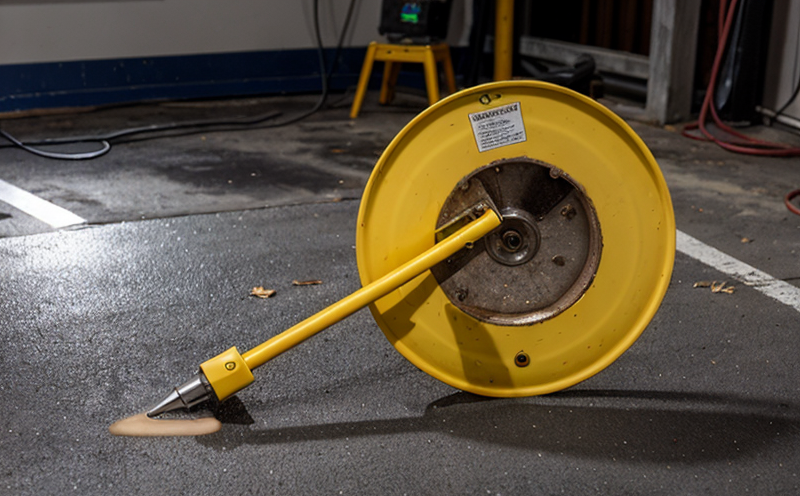ISO 9934 Magnetic Particle Inspection of Welded and AM Components
The ISO 9934 standard is widely used for the non-destructive evaluation (NDE) of materials using magnetic particle inspection (MPI). This technique is particularly valuable in identifying surface and near-surface defects such as cracks, lack of fusion, incomplete penetration, and porosity in welded joints and components produced through additive manufacturing (AM).
When it comes to additive manufacturing, the unique process of layer-wise deposition can lead to complex microstructures that may not be easily discernible with conventional NDE methods. Magnetic Particle Inspection is well-suited for this task as it allows for the visualization of minute discontinuities in ferromagnetic materials, which are common in AM processes.
The first step in performing an ISO 9934 compliant MPI involves thorough preparation of the specimen. This includes cleaning the surface to remove any oil, grease, or paint that might interfere with the inspection process. After cleaning, the component must be carefully inspected for any visible defects such as cracks or porosity. Once this initial assessment is complete, the component is magnetized using an appropriate method (e.g., a magnetic yoke, solenoid, or core bar). A magnetic field is then applied to the specimen, and fine particles of ferromagnetic material are sprayed onto its surface.
The interaction between the magnetic flux leakage from the defect and the external magnetic field causes the particles to accumulate in these areas. This accumulation results in a visible indication that can be detected by visual inspection or through the use of a viewing device such as an ultraviolet light source for enhanced visibility. The presence, size, shape, and location of these indications are recorded meticulously and compared against acceptance criteria outlined in ISO 9934.
The reliability of MPI relies heavily on operator skill and experience. Ensuring that the operator is trained according to international standards such as ISO 17025 guarantees consistency across different operators and laboratories, thus ensuring high-quality results.
| Step | Action | Description |
|---|---|---|
| 1 | Cleaning and Preparation | The specimen is cleaned to remove contaminants and inspected for visible defects. |
| 2 | Magnetization | The specimen is magnetized using an appropriate method, such as a magnetic yoke or solenoid. |
| 3 | Spraying of Magnetic Particles | Ferromagnetic particles are sprayed onto the surface of the specimen. |
| 4 | Inspection and Recordation | The inspector visually inspects for any indications of defects, records their presence, size, shape, and location. |
Scope and Methodology
The scope of ISO 9934 Magnetic Particle Inspection (MPI) is extensive. It applies to the inspection of ferromagnetic materials that have been subjected to welding or additive manufacturing processes. This includes welds, brazed joints, and components produced using AM techniques such as laser powder bed fusion (LPBF), electron beam melting (EBM), and direct metal laser sintering (DMLS).
- Welding: The standard covers various welding processes like gas tungsten arc welding (GTAW), gas metal arc welding (GMAW), and submerged arc welding (SAW).
- Additive Manufacturing: ISO 9934 can be used to inspect parts produced using AM methods. This includes but is not limited to LPBF, EBM, and DMLS.
The methodology outlined in ISO 9934 ensures that the inspection process is consistent and reliable. It specifies the requirements for the magnetic field strength, the type of magnetic particles used, and the procedures for applying these materials onto the surface of the specimen. The standard also provides guidelines on how to interpret the results obtained from the inspection.
For additive manufacturing applications, it's important to note that the unique microstructure resulting from AM processes can sometimes lead to challenges in achieving a uniform magnetic field distribution. Therefore, special attention must be paid during the magnetization step to ensure thorough coverage of all areas of interest.
Benefits
The implementation of ISO 9934 Magnetic Particle Inspection brings numerous benefits to industries relying on welded and AM components. One of the primary advantages is the ability to identify defects early in the manufacturing process, which reduces the likelihood of failure later down the line. Early detection allows for corrective actions to be taken promptly, minimizing downtime and associated costs.
Additionally, MPI provides a non-destructive means of evaluating parts without compromising their structural integrity. This is crucial in industries where maintaining component performance over long periods is essential, such as aerospace or automotive manufacturing. By ensuring that all critical components meet the required standards before deployment, ISO 9934 helps to enhance product reliability and safety.
The standard also supports quality control initiatives by providing a standardized approach to inspecting materials. This consistency across different laboratories ensures that inspections are reliable and comparable, which is vital for compliance with international regulations and industry best practices.
In the context of additive manufacturing, ISO 9934 offers a valuable tool for assessing the integrity of complex geometries that may be difficult to inspect using other methods. The ability to detect defects at an early stage can significantly improve the overall quality of AM parts, thereby enhancing their performance and longevity.
Environmental and Sustainability Contributions
- Eco-friendly Materials: The use of magnetic particles in MPI is generally considered eco-friendly as they do not produce significant waste during the inspection process.
- Reduction in Waste: By identifying defects early, MPI helps to minimize waste by preventing defective components from being further processed or deployed into service.
- Energy Efficiency: The magnetic fields used in MPI are generated using low-power electromagnetic sources, contributing to energy efficiency compared to alternative inspection methods like X-ray or ultrasonic testing.





